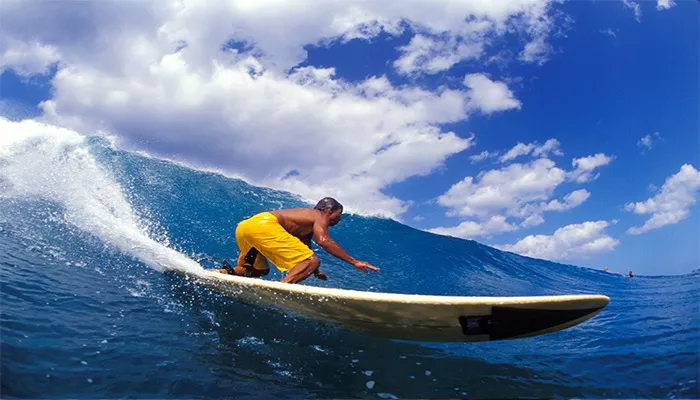Longboard surfing is one of the most iconic and accessible forms of wave riding, blending style, grace, and a deep connection with the ocean. Whether you’re drawn by the nostalgic charm of classic surf culture or the smooth, flowing ride that longboards offer, starting your journey in longboard surfing can be incredibly rewarding. This guide will walk you through everything you need to know to get longboard surfing , from understanding the equipment to mastering the basics of wave riding.
Introduction to Longboard Surfing
Longboard surfing stands apart from shortboard surfing due to the size and shape of the board. Typically ranging from 8 to 12 feet in length, longboards provide greater stability and buoyancy, making them ideal for beginners and those who appreciate a more relaxed, stylish approach to surfing. The longer board allows surfers to catch smaller, slower waves and perform classic maneuvers such as nose riding and cross-stepping.
Longboarding is not just about riding waves; it’s about embracing a lifestyle that values patience, flow, and harmony with nature. For beginners, the longboard’s forgiving nature offers a perfect platform to learn the fundamentals of surfing, build confidence, and develop a lifelong passion.
Choosing Your First Longboard: What to Look For
Board Size and Volume
For beginners, the size and volume of the board are crucial. A longer, wider board with ample volume provides better stability and easier paddling. Generally, a board between 9 and 10 feet with a volume of 60 to 80 liters is ideal for most beginners, depending on your weight and fitness level.
Material and Construction
Longboards come in various constructions:
Polyurethane (PU) with fiberglass: Classic feel, good durability, and repairability.
Epoxy boards: Lighter and more buoyant, great for beginners who want easier paddling.
Soft-top boards: Extremely beginner-friendly with a soft foam deck, minimizing injury risk.
For your first board, a soft-top or epoxy longboard is often recommended due to their durability and ease of use.
Shape and Design
Look for a board with a rounded nose, which is typical for longboards and helps with nose riding and stability. The tail shape can affect maneuverability; a wider tail offers more stability, while a narrower tail allows for sharper turns.
Essential Gear for Longboard Surfing Beginners
Wetsuit
Depending on your local water temperature, a wetsuit may be necessary. Choose a wetsuit thickness that keeps you warm but allows flexibility (e.g., 3/2mm for temperate waters).
Leash
A leash attaches your board to your ankle, preventing it from drifting away after a fall. For longboards, a longer leash (around 9 feet) is recommended to accommodate the board’s length.
Wax and Traction Pads
Surfboard wax improves grip on your board’s deck. Apply it before every session, focusing on the standing area. Some surfers also use traction pads for extra grip, especially on the tail.
Sunscreen and Rash Guards
Protect your skin from sun exposure with waterproof sunscreen and consider wearing a rash guard to prevent irritation from the board.
Learning the Basics: Step-by-Step Guide
1. Understanding Ocean Conditions
Before entering the water, spend time learning about tides, wave types, and currents. Start in small, gentle waves (1-3 feet) with sandy bottoms and minimal hazards. Check local surf reports and talk to experienced surfers or instructors.
2. Paddling Technique
Paddling efficiently is essential for catching waves. Lie flat on your board, keep your body centered, and use long, deep strokes with your arms. Keep your head up to spot incoming waves.
3. Positioning on the Board
Proper positioning affects balance and paddling. Your chest should be slightly raised, with your toes just touching the tail. If you’re too far back, the nose will lift and slow you down; too far forward, and the board will nose dive.
4. Catching Your First Wave
Start by catching whitewater waves close to shore. Paddle hard to match the wave’s speed, then pop up smoothly. Timing is key—start paddling early and commit to the wave.
5. The Pop-Up
The pop-up is the movement from lying down to standing. Practice on land by lying on your stomach, placing your hands under your chest, and pushing up while bringing your feet under you in one quick motion. On the water, keep your movements fluid and balanced.
6. Stance and Balance
Once standing, keep your knees bent and your weight centered over the board. Your feet should be shoulder-width apart, with your front foot near the center and your back foot near the tail. Look forward, not down.
Progressing Your Skills: Maneuvers and Techniques
Cross-Stepping
Cross-stepping is a classic longboard maneuver where you walk your feet up the board’s deck towards the nose. This technique allows you to perform nose rides and adds style to your surfing.
Nose Riding
Nose riding involves walking to the front of the board and balancing with your toes hanging over the nose. It requires wave selection, balance, and timing but is one of the most rewarding longboard experiences.
Turning
Learn to turn by shifting your weight and using your rails (edges of the board). Start with wide, gentle turns and progress to tighter maneuvers as your confidence grows.
Safety Tips for Beginners
Always surf within your limits and conditions.
Never surf alone—have a buddy or surf in areas with lifeguards.
Respect local surf etiquette and other surfers.
Warm up before surfing to prevent injuries.
Learn how to fall safely—try to fall flat and away from your board.
Maintaining Your Longboard
Proper maintenance extends the life of your board:
- Rinse with fresh water after every session
- Store in a cool, shaded place away from direct sunlight
- Repair dings and cracks promptly to prevent water damage
- Reapply wax regularly
Conclusion
Starting with longboard surfing is an exciting adventure that combines physical activity, ocean awareness, and a unique lifestyle. By choosing the right equipment, learning fundamental skills, and respecting the ocean, you’ll build a solid foundation for a lifelong passion. Remember, patience and persistence are key—every surfer started as a beginner, and every wave is an opportunity to improve.

